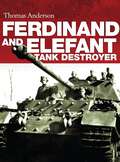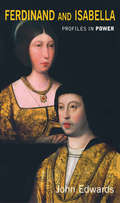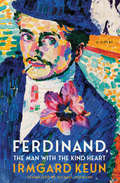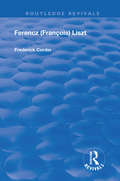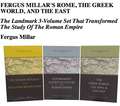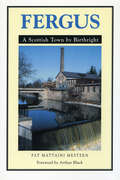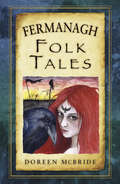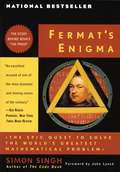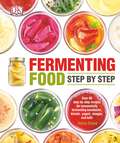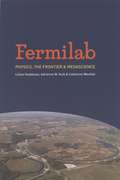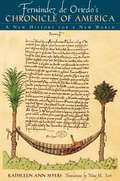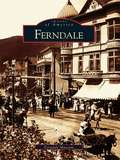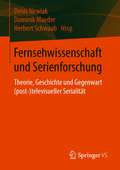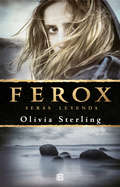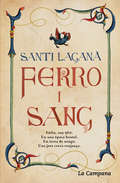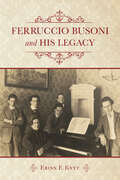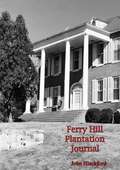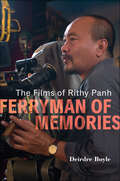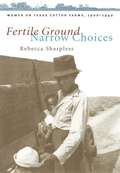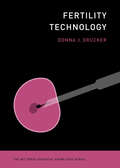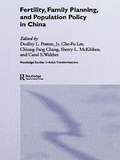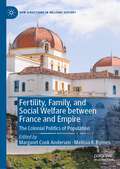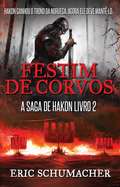- Table View
- List View
Ferdinand and Elefant Tank Destroyer
by Thomas AndersonThis is the story of the largest and statistically most successful tank destroyer of World War II. The Ferdinand was a true behemoth, and although only 91 examples were built, they took a savage toll of Soviet armor in the Battle of Kursk and subsequent operations on the Eastern Front. This study explores the technical development and combat deployment of this remarkable vehicle, from its origins in the Porsche Tiger Tank through its deployment under the designation 'Ferdinand' in the Citadel offensive, to its modification and redesignation as the 'Elefant' and final use in the desperate Battle of Berlin. Drawing on original archival material from within Germany, private collections, and heretofore unpublished photographs this title is an essential illustrated history to one of the most famous armored vehicles ever built.
Ferdinand and Isabella (Profiles In Power #Vol. 36)
by J. EdwardsThis book is about a couple, not a single, dominant ruler. Thus it raises issues of gender, and the dynamics of a marriage over thirty-five years, as well as the practice of monarchical power. The reader sees Ferdinand and Isabella struggle to establish their regime, and then work out an elaborate reform programme in Church and State. It sees them fight a ‘total war’, by fifteenth-century standards, against Muslim Granada, leading to that kingdom’s conquest, and an equally ‘total’ war, through the Inquisition and the Church in general, to convert Spanish Jews and Muslims to Christianity, and to reform and purify the religious and social lives of the established Christians themselves. For readers interested in Early European History.
Ferdinand, The Man with the Kind Heart: A Novel
by Irmgard KeunThe last novel from the acclaimed author of The Artificial Silk Girl, this 1950 classic paints a delightfully shrewd portrait of postwar German society. Upon his release from a prisoner-of-war camp, Ferdinand Timpe returns somewhat uneasily to civilian life in Cologne. Having survived against the odds, he is now faced with a very different sort of dilemma: How to get rid of his fiancée? Although he certainly doesn&’t love the mild-mannered Luise, Ferdinand is too considerate to break off the engagement himself, so he sets about finding her a suitable replacement husband—no easy task given Luise&’s high standards and those of her father, formerly a proud middle-ranking Nazi official.Featuring a lively cast of characters—from Ferdinand&’s unscrupulous landlady with her black-market schemes to his beguiling cousin Johanna and the many loves of her life—Ferdinand captures a distinct moment in Germany&’s history, when its people were coming to terms with World War II and searching for a way forward. In Irmgard Keun&’s effervescent prose, the story feels remarkably modern.
Ferencz (Routledge Revivals)
by Frederick CorderPublished in 1925 this book provides a biographical account of the lifetime achievements of Ferencz François Liszt, one of the most dexterous and prolific musicians of the 19th century.
Fergal's Tale (Fountas & Pinnell Classroom, Guided Reading)
by Scott Brundage Sylvia AndrewsNIMAC-sourced textbook. A Shrieking Wail. The storyteller's howls sent shivers down Fergal's back. He wanted that kind of skill.
Fergus Millar's Rome, the Greek World, and the East, Omnibus E-book
by Guy Maclean Rogers Fergus Millar Hannah M. CottonFergus Millar is one of the most influential contemporary historians of the ancient world. His essays and books, including The Emperor in the Roman World and The Roman Near East, have enriched our understanding of the Greco-Roman world in fundamental ways. In his writings Millar has made the inhabitants of the Roman Empire central to our conception of how the empire functioned. He also has shown how and why Rabbinic Judaism, Christianity, and Islam evolved from within the wider cultural context of the Greco-Roman world.This is a three-volume collection of Fergus Millar's essays, which transformed the study of the Roman Empire by shifting the focus of inquiry onto the broader Mediterranean world and beyond. Volume I: Opening this collection of sixteen essays is a new contribution by Millar in which he defends the continuing significance of the study of Classics and argues for expanding the definition of what constitutes that field. In this volume he also questions the dominant scholarly interpretation of politics in the Roman Republic, arguing that the Roman people, not the Senate, were the sovereign power in Republican Rome. In so doing he sheds new light on the establishment of a new regime by the first Roman emperor, Caesar Augustus.Volume II: This second volume of the three-volume collection of Millar's published essays draws together twenty of his classic pieces on the government, society, and culture of the Roman Empire (some of them published in inaccessible journals). Every article in Volume 2 addresses the themes of how the Roman Empire worked in practice and what it was like to live under Roman rule. As in the first volume of the collection, English translations of the extended Greek and Latin passages in the original articles make Millar's essays accessible to readers who do not read these languages.Volume III: The 18 essays presented here include Millar's classic contributions to our understanding of the impact of Rome on the peoples, cultures, and religions of the eastern Mediterranean, and the extent to which Graeco-Roman culture acted as a vehicle for the self-expression of the indigenous cultures. The volume also includes an epilogue by Millar written to conclude the collection.
Fergus: A Scottish Town By Birthright
by Pat MesternPat Mestern, author of several earlier books and an ardent booster of her hometown, has produced an entertaining personal account of Fergus, while maintaining the historical perspective and utilizing the rich oral history of the area. Her lighter look at some of the characters and the escapades that add flavour to life in small-town Ontario make this a delightful read. Ghost stories and "the legacy of the one-legged chickens" are memorable examples of her Fergus. The settlement of Fergus, originally known as Little Falls, was founded by two Lowland Scots, Adam Fergusson and James Webster, both advocates by profession. The practice they introduced of giving all new streets Scottish names is still maintained by the local council. "I first met Pat Mestern back in 1988 when I arrived in Fergus, Ontario, to perform at the Highland Games. Her gracious reception was the aperture to a community which directly conveyed to me a sense of ’The Auld Country.’ The charm of the town and its surroundings along with the enthusiastic greeting I received from the audience is remembered well and has endeared the people of Fergus to me. I am delighted that this community now has a publication to portray its history so that kindred Celts can discover this ’Wee Bit o’ Scotland’ in Canada." - Alex Beaton, Glenfinnan Music Ltd., Woodland Hills, California.
Fermanagh Folk Tales
by Doreen McBrideFermanagh's culture, heritage, characters and stories set it apart from the rest of the world. Every mountain, tree, lake, stream, rock, stone and character tells a tale. There are the strange stories of mythical creatures, such as the Shining Folk that lurk under the surface of Lough Erne, and the fairies that taught the unruly wee Meg Barnileg a lesson. There are spooky tales of the Cooneen poltergeist that haunted the Murphy family and the ghost of Belleek Pottery. And there are the ‘pants’, or tall tales, that the locals love to retell, such as the stories about ‘educated’ Irish pigs who understood three languages, talking horses or the pike who went ‘fishing’ for squirrels. All these stories and more are featured in this unique collection which will take you deep into the heart of this historic county.
Fermat's Enigma: The Epic Quest to Solve the World's Greatest Mathematical Problem
by Simon Singhxn + yn = zn, where n represents 3, 4, 5, ...no solution"I have discovered a truly marvelous demonstration of this proposition which this margin is too narrow to contain."With these words, the seventeenth-century French mathematician Pierre de Fermat threw down the gauntlet to future generations. What came to be known as Fermat's Last Theorem looked simple; proving it, however, became the Holy Grail of mathematics, baffling its finest minds for more than 350 years. In Fermat's Enigma--based on the author's award-winning documentary film, which aired on PBS's "Nova"--Simon Singh tells the astonishingly entertaining story of the pursuit of that grail, and the lives that were devoted to, sacrificed for, and saved by it. Here is a mesmerizing tale of heartbreak and mastery that will forever change your feelings about mathematics.
Fermenting Food Step by Step: Over 80 step-by-step recipes for successfully fermenting kombucha, kimchi, yogur
by Adam ElabdCreate healthy and delicious fermented foods at home with over 80 step-by-step recipes and beautiful photography. Fermenting Food Step by Step shows you how to master the fermenting process step by step. For thousands of years, cultures around the world have practiced fermentation as a way to preserve food, and only recently have we discovered the full scope of its incredible health benefits. Whether you&’re creating ferments for the incredible flavors or for the amazing health benefits, Fermenting Food Step by Step will give you everything you need to make your own delicious fermented foods at home for everything from kimchi to kefir. Here&’s what you&’ll find inside: • Over 80 recipes for fermenting fruits and vegetables, condiments, dairy, legumes and grains, condiments and vinegars, and more, and each featuring beautiful, instructional photography • Recipes for fermented breads, including instructions for making and using sourdough starters, as well as recipes for non-alcoholic and alcoholic beverages for everything from kombucha to hard cider to mead • Fascinating insight on how fermentation works and the different types of fermentation • Helpful tips for sourcing ingredients, purchasing essential equipment, and ensuring that your ferments always come out safe and flavorful
Fermilab: Physics, the Frontier, and Megascience
by Lillian Hoddeson Adrienne W. Kolb Catherine WestfallFermi National Accelerator Laboratory, located in the western suburbs of Chicago, has stood at the frontier of high-energy physics for nearly forty years. Since 1972, when the laboratory's original particle accelerator began producing the world's highest-energy protons for research, the government-supported scientific facility has been home to numerous scientific breakthroughs, including the discoveries of the top and bottom quarks. Fermilab is the first history of this laboratory and of its powerful accelerators told from the point of view of the people who built and used them for scientific discovery. Focusing on the first two decades of research at Fermilab, during the tenure of the laboratory's charismatic first two directors, Robert R. Wilson and Leon M. Lederman, the authors trace the rise of what they call "megascience," the collaborative struggle to conduct large-scale international experiments in a climate of limited federal funding. This dramatic period of innovation was shaped by an inevitable tension between Fermilab's pioneering ethos and the practical constraints of tightened budgets. Fermilab illuminates the growth of the modern research laboratory during the Cold War and captures the drama of human exploration at the cutting edge of science. It is essential reading for anyone interested in regional history, the history of physics, or institutional history.
Fernandez de Oviedo's Chronicle of America: A New History for a New World
by Kathleen Ann MyersGonzalo Fernández de Oviedo (1478-1557) wrote the first comprehensive history of Spanish America, the Historia general y natural de las Indias, a sprawling, constantly revised work in which Oviedo attempted nothing less than a complete account of the Spanish discovery, conquest, and colonization of the Americas from 1492 to 1547, along with descriptions of the land's flora, fauna, and indigenous peoples. His Historia, which grew to an astounding fifty volumes, includes numerous interviews with the Spanish and indigenous leaders who were literally making history, the first extensive field drawings of America rendered by a European, reports of exotic creatures, ethnographic descriptions of indigenous groups, and detailed reports about the conquest and colonization process. Fernández de Oviedo's Chronicle of America explores how, in writing his Historia, Oviedo created a new historiographical model that reflected the vastness of the Americas and Spain's enterprise there. Kathleen Myers uses a series of case studies--focusing on Oviedo's self-portraits, drawings of American phenomena, approaches to myth, process of revision, and depictions of Native Americans--to analyze Oviedo's narrative and rhetorical strategies and show how they relate to the politics, history, and discursive practices of his time. Accompanying the case studies are all of Oviedo's extant field drawings and a wide selection of his text in English translation. The first study to examine the entire Historia and its evolving rhetorical and historical context, this book confirms Oviedo's assertion that "the New World required a different kind of history" as it helps modern readers understand how the discovery of the Americas became a catalyst for European historiographical change.
Ferndale
by Ferndale MuseumThe enchanting "Victorian Village" of Ferndale in the Eel River Valley is designated a "Distinctive Destination" by the National Trust for Historic Preservation and is a California Historical Landmark. Named by its founders, the Shaw brothers, to honor the six-foot-tall ferns that once choked the thickly forested valley floor, the town became a vital center for goods bound by water for San Francisco and a crossroads for stages to Eureka and Bear River. For many years after the Shaws first paddled their canoe across the Eel River in 1852, travelers forded it by ferry. This changed when Fernbridge was constructed in 1911, at that time the longest reinforced concrete-arch span bridge in the world.
Fernsehwissenschaft und Serienforschung: Theorie, Geschichte und Gegenwart (post-)televisueller Serialität
by Dominik Maeder Denis Newiak Herbert SchwaabFernsehserien erfreuen sich einer ungebrochenen - populären wie wissenschaftlichen - Aufmerksamkeit. Dabei erstaunt, dass in medien- und kulturwissenschaftlichen Arbeiten zur Serialität fernsehwissenschaftliche und -geschichtliche Ansätze noch immer eine eher kleine Rolle spielen. Dabei ist Serialität stets vom Fernsehen her zu denken, sind doch beide schon immer unauflösbar miteinander verwoben gewesen – ökonomisch, technisch und ästhetisch. Doch was macht darüber hinaus das Serielle im Fernsehen aus und wie verändert es sein Gesicht in Zeiten von Digitalisierung, Streaming und Interaktivität? Lässt sich eine genuine Serientheorie des Televisuellen denken – und was lässt sich daraus wiederum für die Serialität jenseits des Fernsehens lernen? Die fernsehwissenschaftlichen Aufsätze dieses Bandes leisten einen Beitrag dazu, das Serielle als Kernprinzip des Fernsehens neu zu beleuchten und anhand vielfältiger Beispiele aus dem aktuellen Fernsehserienangebot neue Impulse für eine Fernsehtheorie des Seriellen zu setzen.
Ferox: Serás leyenda
by Olivia SterlingUn viaje lleno de aventuras y descubrimientos, en el que la joven salvaje que apenas sabía nada del mundo se convirtió en leyenda. «No hay más que ver el fuego de esos ojos: esta niña tiene el corazón de una fiera salvaje.» En los albores del año 1000, mientras media humanidad vive entre el hambre y la miseria, la otra media aguarda con temor la llegada del fin del mundo. La joven Micaela y su padre han pasado la vida aislados en el claro de un bosque, escondiéndose de los asesinos que la buscan. La curiosa e indómita niña crece sin conocer nada de lo que ocurre más allá de su bosque. Una mañana se hacen realidad sus temores: en el claro se presenta un hombre tuerto que viene a llevársela, y ella se ve obligada a huir. Inicia así un viaje lleno de peligros por un medievo sometido a la ley del más fuerte, que la conducirá a encontrar el miedo, la traición y la muerte, pero también el amor. Su destino: descubrir la verdad sobre su origen; una verdad que custodia una mítica comunidad de mujeres libres que sobreviven ocultas en un lugar secreto: la Playa de los Hombres de Piedra.
Ferrari
by Dennis Adler Luigi Chinetti JrA fitting tribute to the ultimate expressions of automotive excellence.In 1945, Enzo Ferrari, the onetime director of Scuderia Ferrari, Alfa Romeo's fabled racing program, emerged from Alfa's shadow to create his own legend. Out of the rubble of World War II, Ferrari established an auto works whose products would surpass anything seen before.Now esteemed automotive journalist, historian, and photographer Dennis Adler presents Ferrari: The Road from Maranello-the stunningly illustrated story of one of the most coveted and recognized automobile lines in the world. Featured are many legendary Ferraris from road and track, including: The Tipo 125, Ferrari's debut production racer The Farina Cabriolet, the first Ferrari for consumers The brutally powerful F50, "the fastest road car ever" Ferrari's Grand Prix and Formula One cars, driven by champions from Alberto Ascari to Niki Lauda to Michael SchumacherChronicled in interviews with racing legends including Dan Gurney, Carroll Shelby, and Phil Hill, as well as renowned Ferrari designers Sergio Pininfarina, Sergio Scaglietti, and many others is the fascinating history of Ferrari through its successes and failures, setbacks and triumphs. Here are first-person stories of legendary battles pitting Ferrari against Ford, Porsche, and other marques on race circuits from Monaco and Monza to Daytona and Le Mans.
Ferro i sang
by Santi LaganàUna novel·la ambientada a la Itàlia medieval protagonitzada per una dona que farà l'impossible per salvar a qui més estima. El segle X arriba a la seva fi, i mentre el tron papal és ocupat per un adolescent capritxós i llibertí, la resta d'Itàlia es desfà en lluites internes i el camp és una terra de ningú on s'imposa la llei del més fort. Quan la fama de l'extraordinària bellesa de l'Anna, la filla de quinze anys d'una família de pagesos pobres, arriba a les orelles del jove papa Joan, sobre la llar de la noia plana l'amenaça d'un senyor cruel que pretén vendre-la com a esclava per a la depravada cort romana. L'Anna, encara que aconsegueix escapar del seu destí, presencia com la seva família és massacrada i el seu germà Martello és capturat. Aleshores decideix que farà el que calgui per rescatar-lo i, amb una determinació indòmita, marxa a buscar-lo i s'endinsa en un món hostil i brutal. Durant el periple trobarà un cavaller amb un passat obscur i un present encara més misteriós, un savi erudit que té a l'abast recursos insospitats i un jove alegre i audaç. Una estranya companyia amb la qual l'Anna intentarà endinsar-se en els palaus més secrets de Roma per trobar el seu germà i dur a terme la seva venjança. SANTI LAGANÀ va néixer el 1954 a Reggio Calàbria, a Itàlia, i es va llicenciar en Dret a la Universitat de Siena el 1978 i va treballar durant molts anys en un dels bancs italians més importants. En l'actualitat gaudeix viu al camp, a Cerveteri, on pot conrear les seves aficions de sempre: la lectura, l'escriptura i la bicicleta. Ferro i sang és el seu debut en el gènere de la novel·la històrica, fruit d'un apassionat estudi de l'Alta Edat Mitjana al qual ha dedicat els últims anys. Ressenyes: «Un llibre intens, potent i profund que aconsello llegir assaborint-lo sense pressa.»La testa fra i libri «La valentia, la determinació, l'orgull i les ganes de viure presents en aquesta novel·la la converteixen en una història complexa i gens predictible, amb una escriptura intensa i atenta a tots els personatges i a una història que resultarà inoblidable… La intensitat i la majestuositat d'aquestes pàgines porta el lector al descobriment de tot un món.»Il mondo di sopra «Ambientacions molt cuidades i personatges ben traçats, dels pagesos als nobles i cardenals, passant pels bàrbars i els sarraïns… Recomano [el llibre] a tots els lectors, absolutament a tots.»Il club delle lettrici compulsive «Una novel·la de potència extraordinària… La ficció es fon amb la realitat històrica en una trama apassionant i absorbent en la qual una dona es converteix en símbol i heroïna d'un període difícil, que encara ho és més per la seva condició.»In Punta di Carta «Una història que arrossega, que absorbeix, que emociona... Són pàgines que contenen molta violència, però encara més esperança.»The Shelter of Books «Una novel·la que indueix a reflexionar sobre el món d'ahir i d'avui, i sobre els drets que ara tenim gràcies a dones com l'Anna, que no es van doblegar als homes que les volien vulnerables i fàcils de dominar.»Non solo Il libro dello scrittore «L'aconsello a tots els afeccionats al gènere històric que estimin les aventures.»Gli occhi del lupo
Ferruccio Busoni and His Legacy
by Erinn E. KnytAn analysis of the composer’s unconventional teaching style and philosophy, his relationship with his students, and his effect on twentieth century music.Many students of renowned composer, conductor, and teacher Ferruccio Busoni had illustrious careers of their own, yet the extent to which their mentor’s influence helped shape their success was largely unexplored until now. Through rich archival research including correspondence, essays, and scores, Erinn E. Knyt presents an evocative account of Busoni’s idiosyncratic pedagogy—focused on aesthetic ideals rather than methodologies or techniques—and how this teaching style and philosophy can be seen and heard in the Nordic-inspired musical works of Sibelius, the unusual soundscapes of Varèse, the polystylistic meldings of music and technology in Louis Gruenberg’s radio operas and film scores, the electronic music of Otto Luening, and the experimentalism of Philip Jarnach. Equal parts critical biography and interpretive analysis, Knyt’s work compels a reconsideration of Busoni’s legacy and puts forth the notion of a “Busoni School” as one that shaped the trajectory of twentieth-century music.“Erinn Knyt’s Ferruccio Busoni and His Legacy is a most welcome addition to the literature on Busoni as a fine example of research based on primary sources.” —Bach
Ferry Hill Plantation Journal, January 4, 1838 to January 15, 1839
by John Blackford Fletcher Melvin GreenFascinating journal of a small farm holder in Maryland in the Antebellum South.“Life at Ferry Hill was very different from that on a major staple crop plantation where the laborers worked in gangs, in routine, and under close supervision. The cultivation and harvesting of corn, wheat, barley, oats, rye, clover, hay, and potatoes; the threshing and milling of the grain; the daily feeding and care of cattle, horses, sheep and hogs, and the slaughter of animals and curing of meats; the growing, harvesting, and preservation of apples, and the manufacture of cider, vinegar, and apple butter therefrom; the daily supervision of the ferry; and the cutting of wood for fuel and timber for lumber and shingles for sale, all of which took place at Ferry Hill, could not easily be carried on by slave gangs in routine and under supervision. Consequently the laborers at Ferry Hill worked individually with little or no supervision. Nor were they assigned tasks to do. Blackford never employed an overseer, he chose to manage the plantation himself and to give general supervision to his slaves and hired laborers. But he did not, as a small farmer would have done, work with his slaves. He did no manual labor. It was his function to formulate policies and see that they were carried out. Nor was Blackford and his plantation unique in this respect. They were typical of many planters and plantations of the Maryland-Virginia area.The Ferry Hill Journal furnishes its own warranty of truth and authenticity. It deals concretely, unconsciously, generally impersonally, and in evident faithfulness with life as it was lived on the plantation. Since Blackford was the supervisor as well as owner he not only saw but experienced the life about which he wrote.”-Introduction.
Ferryman of Memories: The Films of Rithy Panh
by Deirdre BoyleFerryman of Memories: The Films of Rithy Panh is an unconventional book about an unconventional filmmaker. Rithy Panh survived the Cambodian genocide and found refuge in France where he discovered in film a language that allowed him to tell what happened to the two million souls who suffered hunger, overwork, disease, and death at the hands of the Khmer Rouge. His innovative cinema is made with people, not about them—even those guilty of crimes against humanity. Whether he is directing Isabelle Huppert in The Sea Wall, following laborers digging trenches, or interrogating the infamous director of S-21 prison, aesthetics and ethics inform all he does. With remarkable access to the director and his work, Deirdre Boyle introduces readers to Panh’s groundbreaking approach to perpetrator cinema and dazzling critique of colonialism, globalization, and the refugee crisis. Ferryman of Memories reveals the art of one of the masters of world cinema today, focusing on nineteen of his award-winning films, including Rice People, The Land of Wandering Souls, S-21: The Khmer Rouge Killing Machine, and The Missing Picture.
Fertile Ground, Narrow Choices
by Rebecca SharplessRural women comprised the largest part of the adult population of Texas until 1940 and in the American South until 1960. On the cotton farms of Central Texas, women's labor was essential. In addition to working untold hours in the fields, women shouldered most family responsibilities: keeping house, sewing clothing, cultivating and cooking food, and bearing and raising children. But despite their contributions to the southern agricultural economy, rural women's stories have remained largely untold.Using oral history interviews and written memoirs, Rebecca Sharpless weaves a moving account of women's lives on Texas cotton farms. She examines how women from varying ethnic backgrounds--German, Czech, African American, Mexican, and Anglo-American--coped with difficult circumstances. The food they cooked, the houses they kept, the ways in which they balanced field work with housework, all yield insights into the twentieth-century South. And though rural women's lives were filled with routines, many of which were undone almost as soon as they were done, each of their actions was laden with importance, says Sharpless, for the welfare of a woman's entire family depended heavily upon her efforts.
Fertility Technology (The MIT Press Essential Knowledge series)
by Donna J. DruckerA concise overview of fertility technology—its history, practical applications, and ethical and social implications around the world.In the late 1850s, a physician in New York City used a syringe and glass tube to inject half a drop of sperm into a woman&’s uterus, marking the first recorded instance of artificial insemination. From that day forward, doctors and scientists have turned to technology in ever more innovative ways to facilitate conception. Fertility Technology surveys this history in all its medical, practical, and ethical complexity, and offers a look at state-of-the-art fertility technology in various social and political contexts around the world. Donna J. Drucker&’s concise and eminently readable account introduces the five principal types of fertility technologies used in human reproduction—artificial insemination; ovulation timing; sperm, egg, and embryo freezing; in vitro fertilization; and IVF in uterine transplants—discussing the development, manufacture, dispersion, and use of each. Geographically, it focuses on countries where innovations have emerged and countries where these technologies most profoundly affect individuals and population policies. Drucker&’s wide-ranging perspective reveals how these technologies, used for birth control as well as conception in many cases, have been critical in shaping the moral, practical, and political meaning of human life, kinship, and family in different nations and cultures since the mid-nineteenth century.
Fertility, Family Planning and Population Policy in China (Routledge Studies in Asia's Transformations #Vol. 1)
by Dudley L. Poston Jr Che-Fu Lee Chiung-Fang Chang Sherry L. McKibben Carol S. WaltherChina's one-child population policy, first initiated in 1979, has had an enormous effect on the country’s development. By reducing its fertility in the past two decades to less than two children per woman, and developing a family planning program focused heavily on sterilization and abortion, China has undergone a significant transition in status to a demographically developed country. Bringing together contributions from leading academics, this book looks at the impact of the government's strict control over planning and population growth on the family, the wider society and the country's demography. The contributors examine developments such as family planning policy and contraceptive use, biological and social determinants of fertility, patterns of family and marriage and China's future population trends. As such it will be essential reading for academics, researchers, policy makers and government officials with an interest in China’s population policy.
Fertility, Family, and Social Welfare between France and Empire: The Colonial Politics of Population (New Directions in Welfare History)
by Margaret Cook Andersen Melissa K. ByrnesThis edited volume focuses on social welfare and medicine within the French Empire and brings together important currents in both imperial history and the history of medicine. The book covers a broad period from the ‘first colonial empires’ that existed prior to 1830, the ‘new imperialism’ of the late nineteenth and early twentieth centuries, the process of decolonisation in the mid-twentieth century, and the ‘afterlives’ of colonial regimes in France and newly-independent states. Building on recent scholarship, this volume examines the extension of imperialism into the post-colonial period. The chapters examine a range of topics developing our understanding of the reasons why colonial states saw the family as a site for biopolitical intervention. The authors argue that experts built a racialised body of knowledge about colonial populations through census data and medical understandings of problems such as child mortality and infertility. They show that by analysing and compiling data on fertility, population growth (or decline), and health, this fuelled interventions designed to ensure a stable workforce, and that protecting children and mothers, vaccinating vulnerable populations, and creating modern, sanitary housing were all initiatives also aimed at serving larger goals of preserving colonial rule. Finally, the book shows that social welfare projects during the French Empire reflected concerns about race, differential fertility, and migration that continued well after decolonisation.
Festim de Corvos
by Eric SchumacherHakon Haraldsson volta nesta aventura histórica de ritmo acelerado ambientada na Era Viking da Noruega. É 935 A.D. e Hakon Haraldsson acaba de tomar o Alto Assento do Norte de seu cruel irmão, Erik Bloodaxe. Agora, ele deve lutar para mantê-lo. A terra faminta dos dinamarqueses está pressionando pelo sul para testar Hakon antes que ele possa consolidar sua lei. Ao leste, os povos das Uplands estão fazendo seus próprios planos para tomar o trono. Não auxilia o fato de Hakon estar comprometido com seu sonho de Crisianizar seu povo - um sonho que seus conterrâneos não partilham e lutarão para resistir. Conforme seus inimigos movem-se e seu reino começa a desmoronar, Hakon e seu bando de guerreiros juramentados devem suportar em Festim de Corvos, a sequência fascinante de O Martelo de Deus. Comentários: ...Mais de 250 páginas sentando na beira de seu assento... - Dads & Dragons - ...uma leitura excitante sobre um rei muito jovem tentando manter um reino ruindo. - Historical Novel Society- Uma história envolvente de um homem encarando uma situação cada vez mais impossível. - Historical Fiction Review -
